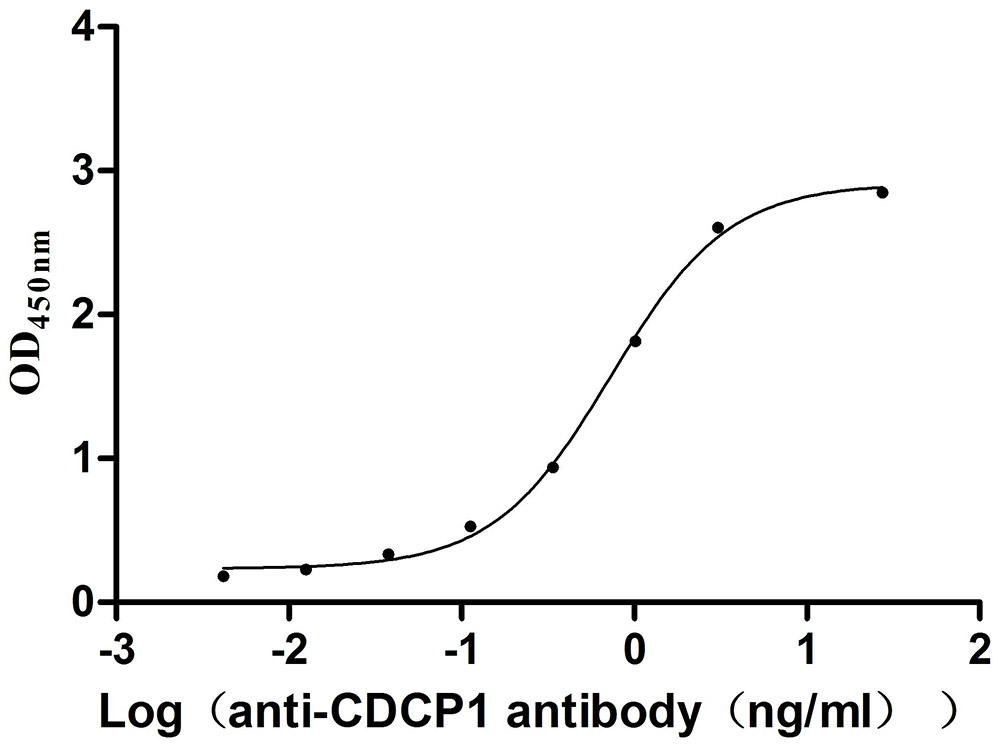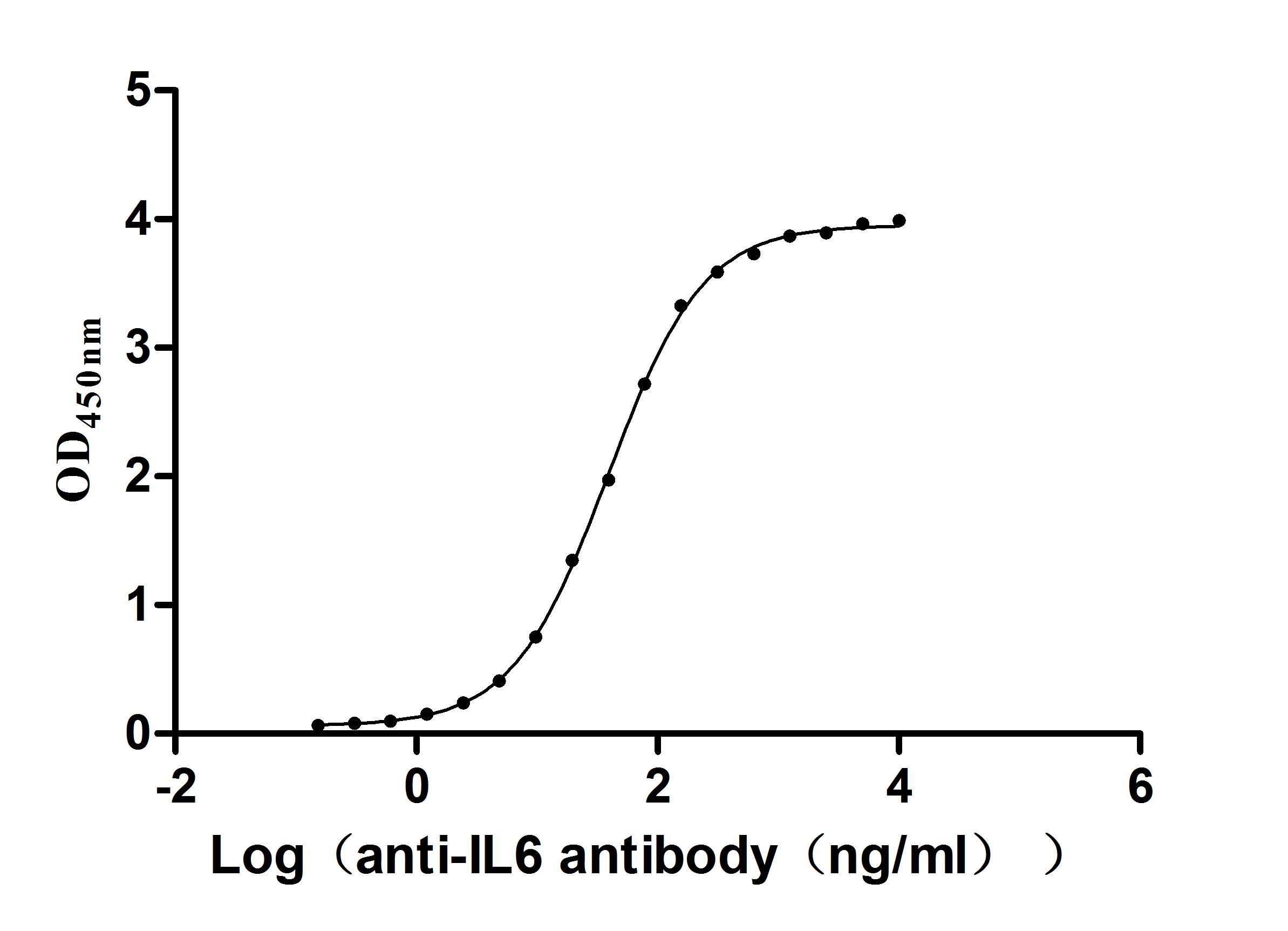Recombinant Mouse Epidermal growth factor-like protein 7 (Egfl7)
-
中文名称:小鼠Egfl7重组蛋白
-
货号:CSB-YP882551MO
-
规格:
-
来源:Yeast
-
其他:
-
中文名称:小鼠Egfl7重组蛋白
-
货号:CSB-EP882551MO
-
规格:
-
来源:E.coli
-
其他:
-
中文名称:小鼠Egfl7重组蛋白
-
货号:CSB-EP882551MO-B
-
规格:
-
来源:E.coli
-
共轭:Avi-tag Biotinylated
E. coli biotin ligase (BirA) is highly specific in covalently attaching biotin to the 15 amino acid AviTag peptide. This recombinant protein was biotinylated in vivo by AviTag-BirA technology, which method is BriA catalyzes amide linkage between the biotin and the specific lysine of the AviTag.
-
其他:
-
中文名称:小鼠Egfl7重组蛋白
-
货号:CSB-BP882551MO
-
规格:
-
来源:Baculovirus
-
其他:
-
中文名称:小鼠Egfl7重组蛋白
-
货号:CSB-MP882551MO
-
规格:
-
来源:Mammalian cell
-
其他:
产品详情
-
纯度:>85% (SDS-PAGE)
-
基因名:Egfl7
-
Uniprot No.:
-
别名:Egfl7; Megf7Epidermal growth factor-like protein 7; EGF-like protein 7; Multiple epidermal growth factor-like domains protein 7; Multiple EGF-like domains protein 7; NOTCH4-like protein; Vascular endothelial statin; VE-statin; Zneu1
-
种属:Mus musculus (Mouse)
-
蛋白长度:Full Length of Mature Protein
-
表达区域:22-275
-
氨基酸序列EHVYRPSRR VCTVGISGGS ISETFVQRVY QPYLTTCDGH RACSTYRTIY RTAYRRSPGV TPARPRYACC PGWKRTSGLP GACGAAICQP PCGNGGSCIR PGHCRCPVGW QGDTCQTDVD ECSTGEASCP QRCVNTVGSY WCQGWEGQSP SADGTRCLSK EGPSPVAPNP TAGVDSMARE EVYRLQARVD VLEQKLQLVL APLHSLASRS TEHGLQDPGS LLAHSFQQLD RIDSLSEQVS FLEEHLGSCS CKKDL
-
蛋白标签:Tag type will be determined during the manufacturing process.
The tag type will be determined during production process. If you have specified tag type, please tell us and we will develop the specified tag preferentially. -
产品提供形式:Lyophilized powder
Note: We will preferentially ship the format that we have in stock, however, if you have any special requirement for the format, please remark your requirement when placing the order, we will prepare according to your demand. -
复溶:We recommend that this vial be briefly centrifuged prior to opening to bring the contents to the bottom. Please reconstitute protein in deionized sterile water to a concentration of 0.1-1.0 mg/mL.We recommend to add 5-50% of glycerol (final concentration) and aliquot for long-term storage at -20℃/-80℃. Our default final concentration of glycerol is 50%. Customers could use it as reference.
-
储存条件:Store at -20°C/-80°C upon receipt, aliquoting is necessary for mutiple use. Avoid repeated freeze-thaw cycles.
-
保质期:The shelf life is related to many factors, storage state, buffer ingredients, storage temperature and the stability of the protein itself.
Generally, the shelf life of liquid form is 6 months at -20°C/-80°C. The shelf life of lyophilized form is 12 months at -20°C/-80°C. -
货期:Delivery time may differ from different purchasing way or location, please kindly consult your local distributors for specific delivery time.Note: All of our proteins are default shipped with normal blue ice packs, if you request to ship with dry ice, please communicate with us in advance and extra fees will be charged.
-
注意事项:Repeated freezing and thawing is not recommended. Store working aliquots at 4°C for up to one week.
-
Datasheet :Please contact us to get it.
相关产品
靶点详情
-
功能:Regulates vascular tubulogenesis in vivo. Inhibits platelet-derived growth factor (PDGF)-BB-induced smooth muscle cell migration and promotes endothelial cell adhesion to the extracellular matrix and angiogenesis.
-
基因功能参考文献:
- EGFL7 reduces CNS inflammation in the experimental autoimmune encephalomyelitis mouse model of multiple sclerosis. PMID: 29483510
- Egfl7 is crucial for placental vascularization and embryonic growth. PMID: 28526753
- the angiogenic factor Egfl7 activates the Flt3/Flt3 ligand pathway and is a key molecular driver enforcing thymus progenitor generation and thereby directly links endothelial cell biology to the production of T cell-based adaptive immunity PMID: 28601636
- EGFL7 is required for VEGF upregulation of the Akt/Erk (1/2) pathway during angiogenesis. PMID: 24647208
- EGFL7 enhances EGFR-AKT signaling, epithelial-mesenchymal transition, and metastasis of gastric cancer cells. PMID: 24945379
- Egfl7 could be a HIF-1alpha responsive gene regulated by oxygen tension. PMID: 25539718
- Using the BPH/5 model of pre-eclampsia (PE), we show that the downregulation of Egfl7 in compromised placentas occurs prior to the onset of characteristic maternal signs of PE. PMID: 24751645
- egfl7 is initially expressed in all endothelial cells and then is progressively restricted to veins and to their neighbouring capillaries. PMID: 24595089
- EGFL7 is expressed in the bone microenvironment and has a role in promoting endothelial cell migration and tube-like structure formation through integrin-mediated pathways. PMID: 24909139
- Expression of Egfl7 in breast and lung carcinoma cells accelerates tumor growth and metastasis in immunocompetent mice but not in immunodeficient mice. PMID: 22037871
- Overexpression of endothelial Egfl7 is associated with impaired angiogenesis and altered Notch signaling PMID: 20947685
- the expression of the VE-statin/egfl7 gene in endothelial cells and the specific importance of ETS and GATA factors PMID: 20808444
- is the first identified inhibitor of mural cell migration specifically produced by endothelial cells. PMID: 14592969
- regulator that controls a specific and important step in vasculogenesis PMID: 15085134
- EGFL7 protein is localized to the endoplasmic reticulum and Golgi apparatus, suggesting that the protein is targeted for secretion PMID: 15162510
- The recombinant protein is pure as assessed by SDS-PAGE, immunoblot and mass spectrometry, and is biologically active as a repressor of human aortic smooth muscle cell migration induced by platelet-derived growth factor-BB. PMID: 16169248
- EGFL7 defines the optimal path of endothelial cells movement by assuring the correct positioning of each EC in a nascent sprout. PMID: 17626061
- EGFL7 provides a proper microenvironment for endothelial cell migration, thereby enabling accurate patterning. PMID: 18300411
- VE-statin/egfl7 produced by endothelial cells binds to the catalytic domains of enzymes of the LOX family in the vascular wall, thereby preventing the crosslink of tropoelastin molecules into mature elastin polymers and regulating vascular elastogenesis. PMID: 18497746
- Results provide the first evidence of a non-endothelial expression of EGFL7 and suggest distinctive roles for Egfl7 in vascular development and germ cell differentiation. PMID: 18556249
- demonstrate the regulation of angiogenesis by an endothelial miRNA, attribute previously described Egfl7 vascular phenotypes to miR-126, and document inadvertent miRNA dysregulation as a complication of knockout strategies PMID: 18987025
- Data identified neurons as a source of EGFL7 in the brain, suggesting that brain-derived EGFL7 acts as an endogenous antagonist of Notch signalling that regulates proliferation and differentiation of subventricular zone-derived adult NSCs. PMID: 19503073
- Egfl7 promotes metastasis of hepatocellular carcinoma (HCC) by enhancing cell motility through EGFR-dependent FAK phosphorylation. PMID: 19824075
显示更多
收起更多
-
亚细胞定位:Secreted, extracellular space.
-
组织特异性:Expressed specifically by endothelial cells of the highly vascularized organs heart, lung and kidney.
-
数据库链接:
KEGG: mmu:353156
STRING: 10090.ENSMUSP00000099971
UniGene: Mm.268933
Most popular with customers
-
Recombinant Human Tumor necrosis factor ligand superfamily member 8 (TNFSF8), partial (Active)
Express system: Mammalian cell
Species: Homo sapiens (Human)
-
Recombinant Human Signal transducer CD24 (CD24)-Nanoparticle (Active)
Express system: Mammalian cell
Species: Homo sapiens (Human)
-
Recombinant Macaca mulatta Microtubule-associated protein tau (MAPT) (Active)
Express system: Mammalian cell
Species: Macaca mulatta (Rhesus macaque)
-
Recombinant Human Somatostatin receptor type 2 (SSTR2)-VLPs (Active)
Express system: Mammalian cell
Species: Homo sapiens (Human)
-
Recombinant Human Desmoglein-2 (DSG2), partial (Active)
Express system: Mammalian cell
Species: Homo sapiens (Human)
-
Recombinant Mouse CUB domain-containing protein 1 (Cdcp1), partial (Active)
Express system: Mammalian cell
Species: Mus musculus (Mouse)
-
Recombinant Human Interleukin-2 (IL2) (Active)
Express system: Mammalian cell
Species: Homo sapiens (Human)
-




















